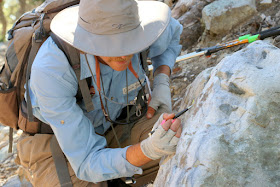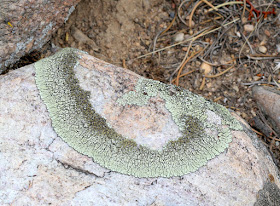Following some talks and a potluck lunch, we split into groups and went out to explore. On the first afternoon, I went out to Snake Creek with a group led by BYU professor Steve Leavitt. He showed us a variety of places that lichens grow.

Tree branches often have some lichens on them, like this Xanthomendoza.

A handlens was really helpful to see some of the tiny parts of the lichens. I was glad I had brought my macro lens for my camera.

I can't quite remember what all I saw that first afternoon. There was so much information that it was all a bit of a blur. On one water birch next to Snake Creek, Steve circled the tree. I asked him how many lichen species he was seeing. He replied at least ten. Whoa!
I knew I had a lot to learn! The next day I headed up to the glacier with Devin.

It turned out this was a good hike to get some lichens straight in my head. We kept seeing the same ones over and over, so it was great practice. Here's elegant starburst lichen, Xanthoria elegans, one of the most common lichens in the park. It grows at all elevations, usually on rocks.

This white and black lichen is the roadmap lichen, Lecidea tessalata.

This lichen had little trumpets emerging from it, so cool! (Cladonia species)

Devin was very patient and did a great job of explaining not only lichens, but also overall forest ecology.

One thing that fascinated me was how many bryophytes (mosses) were around. They are much fuzzier than lichens. And when you look at them really close up, they are amazing.

The shapes of the lichens are fascinating. Here's a Rhizoplaca.

And a different species of Rhizoplaca. Those little round plates helped me remember the name.

We progressed up the trail and got to the bristlecones. Tucked away in the interior of a dead bristlecone was some wolf lichen (Letharia vulpina). It looked totally different than the other lichens we had seen.

One tree had mega-sized wolf lichen on it. So cool! These lichens can be used to make a yellow dye. They've also been used to poison foxes and wolves in Europe.

Up by the glacier we found some orange stains on some rocks, while there was more Xanthoria on others. We also found lots of yellow Candelariella (sort of sounds like candle, which makes it easy to remember), little bits of black Sarcogyne, a black lichen that grows in the rock (so it gets the neat title of being endolithic), and a couple more kinds of Rhizoplaca.

After exploring the glacier area, we went to Teresa Lake. Time out for a sphinx (hummingbird) moth on some Parry's primrose.

Devin then found this Rhizocarpon lichen under water at the spring that feeds Teresa Lake. Who knew that lichens can grow underwater?

After another night of camping out at the Wheeler Peak Campground, we packed up and headed to different places. I joined USU professor Brad Kropp at the picnic area, where we started off by looking at soil lichens.
This is Psora, a brown lichen with white-rimmed edges.

And if it's green and kind of blotchy, it could be Xanthoparmelia.

Can you identify any lichens in this photo?
The orange is Xanthoria elegans, the yellow is Candelariella, and the white and black is Lecidea tesselata. I'm not sure what the grey one is. Oh yeah, and it looks like there's a little bit of the endolithic lichen, Sarcogyne.
If you don't know them all, don't worry. The experts don't either. It looks like at least one new species of lichen was found during the BioBlitz. This is a species that science didn't know about before this BioBlitz. How cool is that?

Here are the folks who were still around after the delicious closing lunch (thanks Great Basin National Park Foundation!), preliminary results talks (thanks Brad and Steve!), and raffle prize drawing (thanks Western National Parks Association!).

It will take the experts a few months to finish identifying what was found at the BioBlitz. It was a great three days, and I won't ever look at lichens in quite the same way





Great macro pictures!
ReplyDeleteThat moth is awesome. The lichens pretty neat too.
ReplyDelete